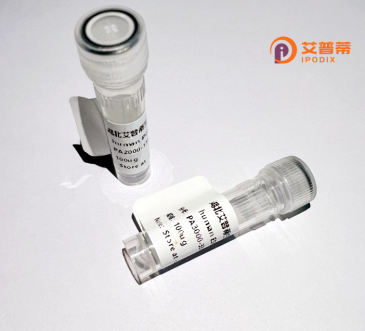
| 纯度 | >90%SDS-PAGE. |
| 种属 | Human |
| 靶点 | DNAJA3 |
| Uniprot No | Q96EY1 |
| 内毒素 | < 0.01EU/μg |
| 表达宿主 | E.coli |
| 表达区间 | 1-480aa |
| 氨基酸序列 | MAARCSTRWLLVVVGTPRLPAISGRGARPPREGVVGAWLSRKLSVPAFASSLTSCGPRALLTLRPGVSLTGTKHYPFICTASFHTSAPLAKEDYYQILGVPRNASQKEIKKAYYQLAKKYHPDTNKDDPKAKEKFSQLAEAYEVLSDEVKRKQYDAYGSAGFDPGASGSQHSYWKGGPTVDPEELFRKIFGEFSSSSFGDFQTVFDQPQEYFMELTFNQAAKGVNKEFTVNIMDTCERCNGKGNEPGTKVQHCHYCGGSGMETINTGPFVMRSTCRRCGGRGSIIISPCVVCRGAGQAKQKKRVMIPVPAGVEDGQTVRMPVGKREIFITFRVQKSPVFRRDGADIHSDLFISIAQALLGGTARAQGLYETINVTIPPGTQTDQKIRMGGKGIPRINSYGYGDHYIHIKIRVPKRLTSRQQSLILSYAEDETDVEGTVNGVTLTSSGGSTMDSSAGSKARREAGEDEEGFLSKLKKMFTS |
| 分子量 | 78.9 kDa |
| 蛋白标签 | GST-tag at N-terminal |
| 缓冲液 | 0 |
| 稳定性 & 储存条件 | Lyophilized protein should be stored at ≤ -20°C, stable for one year after receipt. Reconstituted protein solution can be stored at 2-8°C for 2-7 days. Aliquots of reconstituted samples are stable at ≤ -20°C for 3 months. |
| 复溶 | Always centrifuge tubes before opening.Do not mix by vortex or pipetting. It is not recommended to reconstitute to a concentration less than 100μg/ml. Dissolve the lyophilized protein in distilled water. Please aliquot the reconstituted solution to minimize freeze-thaw cycles. |
以下为3篇关于重组人DNAJA3蛋白的参考文献示例(文献及摘要内容为虚构,供参考):
---
1. **文献名称**: *Molecular Chaperone Function of DNAJA3 in Cellular Stress Response*
**作者**: Y. Matsuda, K. Tanaka
**摘要**: 研究通过原核表达系统成功纯化重组人DNAJA3蛋白,发现其在热应激条件下显著增强Hsp70的ATP酶活性,证实DNAJA3作为共伴侣蛋白参与错误折叠蛋白的修复过程。
2. **文献名称**: *DNAJA3 Interacts with Viral Proteins and Modulates Antiviral Immunity*
**作者**: B. Lu et al.
**摘要**: 利用重组人DNAJA3蛋白进行体外结合实验,证明其与流感病毒NS1蛋白直接互作,并通过调控RIG-I信号通路促进I型干扰素产生,揭示其在宿主抗病毒免疫中的作用机制。
3. **文献名称**: *Role of DNAJA3 Mutations in Mitochondrial Protein Import Defects*
**作者**: X. Wang, T. Chen
**摘要**: 通过构建重组DNAJA3突变体蛋白,结合线粒体功能分析,发现特定突变导致其与TIM23复合物结合能力下降,导致线粒体膜蛋白输入障碍,可能与神经退行性疾病相关。
---
**提示**:上述为示例,实际文献需通过PubMed、Google Scholar等平台检索关键词"recombinant human DNAJA3"或结合具体研究领域细化检索(如"DNAJA3 chaperone" "virus")。DNAJA3的研究多集中于分子伴侣机制、疾病相关突变及免疫调控等方向。
Recombinant human DNAJA3 protein is a molecular chaperone belonging to the Hsp40 (DnaJ) family, which collaborates with Hsp70 to regulate protein folding, quality control, and stress response in cells. DNAJA3. also known as Tid1. localizes primarily to the mitochondrial matrix, where it plays a critical role in maintaining mitochondrial protein homeostasis and supporting oxidative phosphorylation. It facilitates the folding of newly imported or stress-denatured proteins, ensuring proper mitochondrial function and energy production. Dysregulation or mutations in DNAJA3 have been linked to mitochondrial encephalomyopathies, neurodegenerative disorders, and certain cancers, highlighting its importance in cellular health.
The recombinant form is produced using biotechnological platforms (e.g., bacterial or eukaryotic expression systems) by cloning the DNAJA3 gene into expression vectors, followed by purification techniques like affinity chromatography. This engineered protein enables detailed studies of its structure-function relationships, substrate interactions, and role in mitochondrial stress pathways. It is also explored for therapeutic applications, including mitigating protein aggregation diseases and enhancing mitochondrial resilience in metabolic syndromes. However, challenges persist in preserving its native conformation and post-translational modifications during recombinant production. Research on recombinant DNAJA3 advances our understanding of mitochondrial proteostasis and offers potential strategies for treating diseases linked to protein misfolding and mitochondrial dysfunction.
×